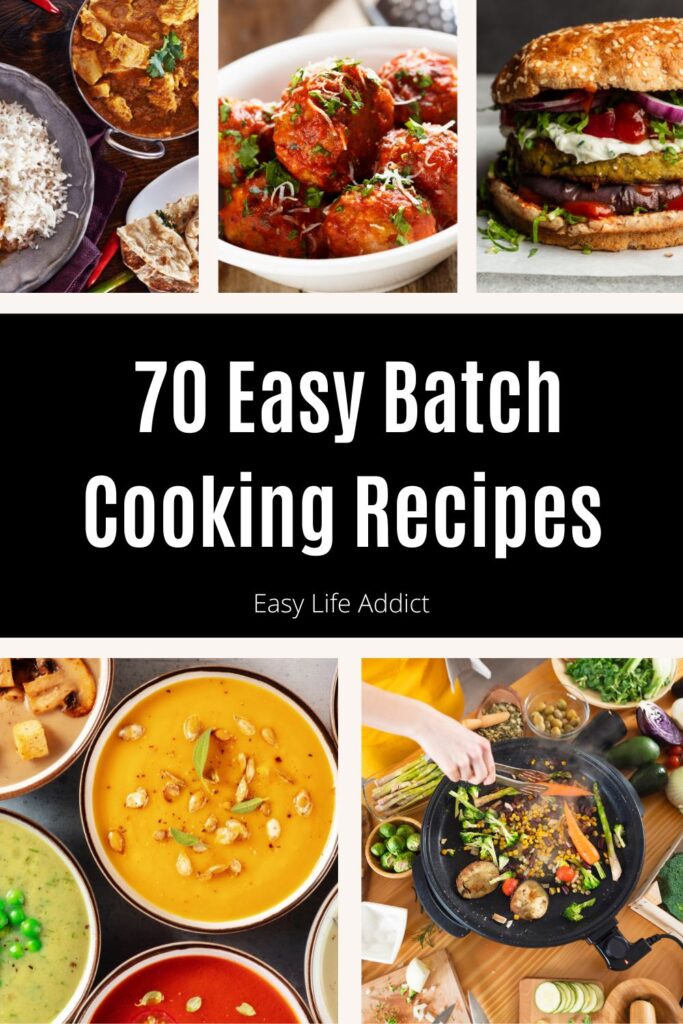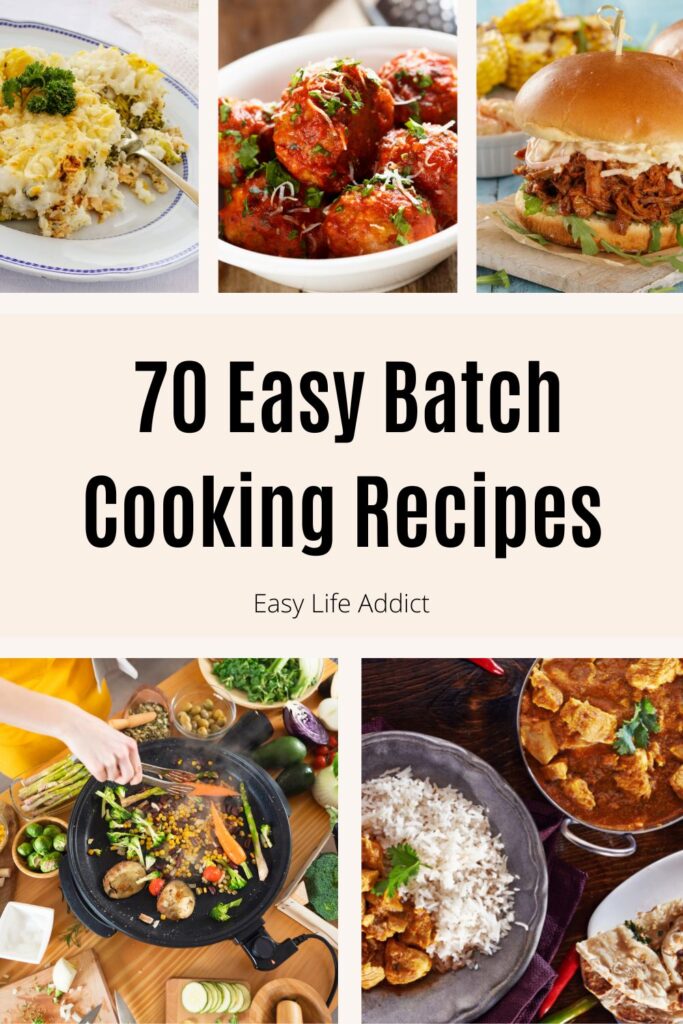70 Simple Freeze-Prep and Batch Cooking Recipes!
Do you struggle to make dinner every night after a long day at work or college? If you’re nodding your head in agreement, batch cooking might be for you! Batch cooking is a meal prep technique in which you cook multiple meals at once and store them in the fridge or freezer to enjoy later. Not only does it save time, but it can also help you save money by reducing food waste and leftovers.
To get started with batch cooking, check out this beginner’s guide with 70 recipes perfect for families or students on the go. Whether you’re looking for breakfast, lunch, dinner, or snacks, we’ve got you covered. So what are you waiting for? Start batch cooking today!
This post may contain affiliate links. That means that if you click on a link and purchase something I recommend, I will receive a small commission at no extra cost to you. As an Amazon Associate, I earn from qualifying purchases. This helps keep my website up and running and is very appreciated. Thank you for your support! You can read my full disclosure policy here.
What is Batch Cooking?
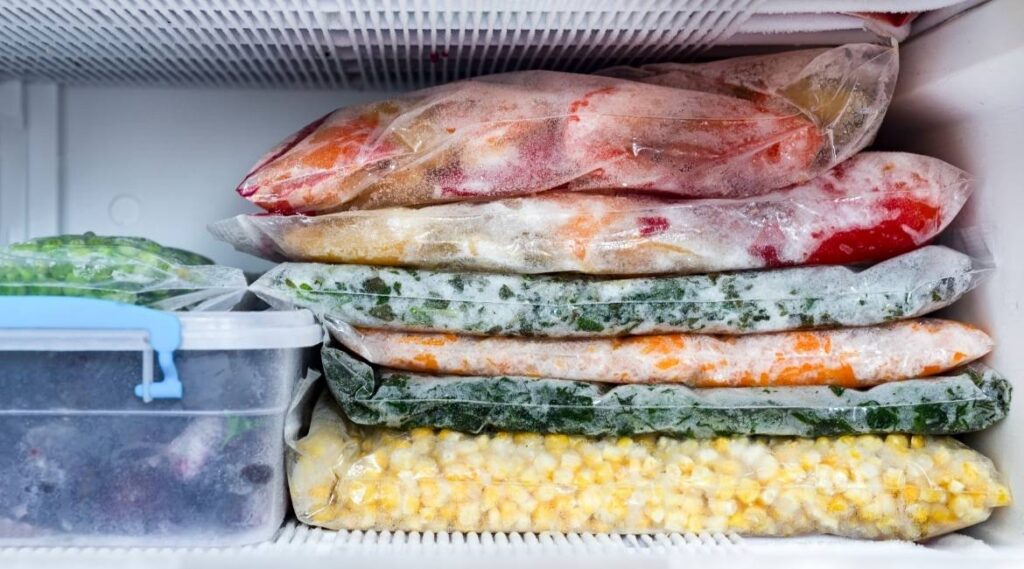
Batch cooking is when you make multiple meals at once. This can be a great time saver during the week when you are busiest. You can make a bunch of meals on the weekend and then have them ready to eat during the week. This way, you don’t have to cook every night and can save time and money. Plus, it’s a great way to eat healthy, home-cooked meals.
Batch cooking can be a bit of an investment upfront, but it will save you time and money in the long run. It’s also a great way to ensure you’re always eating healthy meals. So, if you’re looking for a way to save time and money and eat healthily, batch cooking is for you!
What is Freeze-Prep?

Freeze-prep meals are prepared and then frozen before they are cooked. This can be a huge time saver, especially if you are short on time or only have a few minutes to cook each night.
Freeze-prep meals can be as simple or as complicated as you want them to be. You can prepare a variety of meals, sauces, and vegetables or pre-cook chicken breasts or other meats and freeze them for future use. The possibilities are endless!
The key to successful freeze-prep is to ensure your food is properly sealed and labelled so that you can quickly identify it and know when it was made. With a bit of planning, freeze prep can help you get dinner on the table quickly and easily.
Batch Cooking Vs Meal Planning
Batch cooking and meal planning are two great ways to save time and money in the kitchen. But what exactly is the difference between these two approaches?
Batch cooking involves cooking big batches of food at once so that you have plenty of leftovers to eat throughout the week. Meal planning, on the other hand, involves taking the time to plan each meal in advance. This can be helpful if you have a busy schedule or prefer more control over your eating.
Both batch cooking and meal planning can be great time-savers, but they each have benefits and drawbacks. Batch cooking is less flexible than meal planning, but it can be a lot cheaper since you only have to cook once per week. Meal planning requires more effort upfront, but you can be more spontaneous with your meals since you already know what ingredients you have on hand.
So, which approach is right for you? That depends on your personal preferences and lifestyle. If you like to know exactly what you’re going to eat ahead of time, meal planning is probably a better fit. If you’re tight on budget or prefer having leftovers on hand, batch cooking might be the way to go. Ultimately, there’s no right or wrong answer. It just depends on what works best for you!
Read more: A beginners guide to meal planning
Do you Need Special Equipment for Batch Cooking?
You might think that you need special equipment to batch cook effectively, but that’s simply not the case. You only need a large pot or Dutch oven, a good knife, and a few basic pantry staples. With these tools, you can cook up a big batch of chilli, soup, or pasta sauce that will last you days or even weeks in the freezer.
So whether you’re new to batch cooking or looking to streamline your process, there’s no need to invest in fancy gadgets. Just get out of your trusty pot and get cooking.
Which Foods Freeze Well?
When it comes to batch cooking, some foods are better suited for freezing than others. Curries, chillis and soups all freeze well, and their flavours develop and improve over time. Puddings and pies can also be frozen, although it’s best to wrap them tightly to prevent freezer burn.
In general, it’s best to avoid freezing foods that contain a lot of water, such as lettuce or cucumber. These will become mushy and unpleasant when thawed. With a bit of planning, batch cooking can be a great way to make the most of your time in the kitchen. Choosing the right recipes and knowing which foods freeze well can help you whip up big batches of delicious meals that will last you for weeks.
Foods you should avoid freezing are fried foods, mayonnaise and sour cream, cheese, salads, and cream-based sauces.
70 Batch Cooking Recipes:
Some of the following recipes are not necessarily made for batch cooking, but they can easily be adjusted accordingly. Recipes such as stir-fries can be prepared, then frozen and cooked as needed, while others, such as soups, can be cooked, cooled and then frozen. Some recipes may need some items added before serving, such as cheese, dressings or a side dish.
Soup Batch Cooking Recipes:
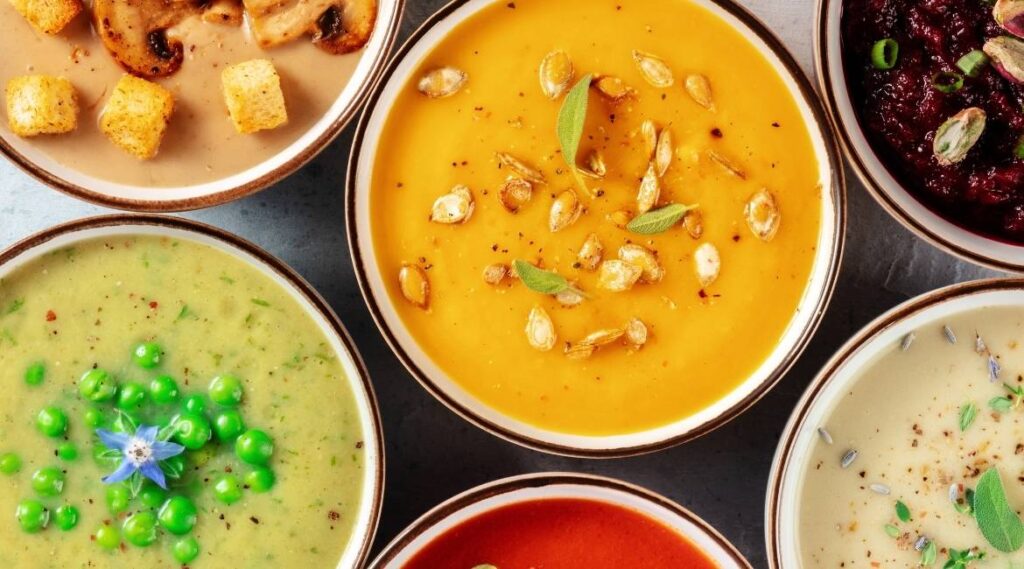
- Red pepper and sweet potato soup from Georgie Eats
- Roasted garlic and miso soup from The Simple Veganista
- Creamy Hungarian mushroom soup from Little Spice Jar
- Thai coconut chicken soup from 40 Aprons
- Golden cauliflower soup from A Couple Cooks
- Creamy chicken Enchilada Soup from Healthy Fitness Meals
- Jalapeño popper bacon and bean Soup from Closet Cooking
- Chicken and wild rice soup from Damn Delicious
- Creamy vegan corn chowder from Ambitious Kitchen
- Tomato soup from Two Spoons
Vegetarian Batch Cooking Recipes:

- Quinoa chickpea meatballs from Oh My Veggies
- Vegetarian quesadillas from I Food Real
- Roasted veggie burritos from Skinny Ms
- Chipotle pumpkin veggie burgers from Peas and Crayons
- Sweet potato falafel from Bianca Zepatka
- Mushroom and goat cheese frittata from The Grateful Grazer
- Caribbean vegan plantain curry from That Girl Cooks Healthy
- White pesto spinach lasagna from Half Baked Harvest
- Caramelised Shiitake Mushroom Risotto from Minimalist Baker
- Tofu & Mushrooms in Black Pepper Sauce from That Spicy Chick
Chicken Batch Cooking Recipes:

- Chicken and broccoli casserole from Pinch of Yum
- Easy Chicken curry from Kitchen Sanctuary
- Skillet Chicken and Mushroom Wine Sauce from Saving Room for Dessert
- Crock Pot Chicken Teriyaki from I Hate Meal Prep
- Slow Cooker Salsa Verde Tacos from Carlsbad Cravings
- Baked chicken nuggets from Natasha’s Kitchen
- Chicken burritos from Simple Recipes
- Caribbean chicken from The Chaos and the Clutter
- Chicken cakes from A family Feast
- Chicken pot pie from Taste of Home
Beef Batch Cooking Recipes:
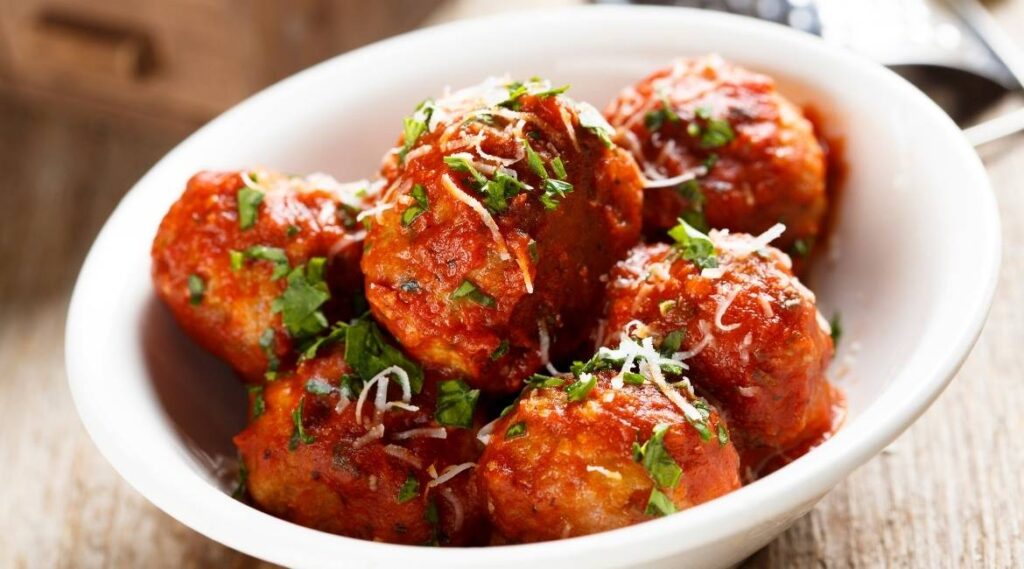
- Chipotle meatballs from How Sweet Eats
- Korean beef tacos from Damn Delicious
- Mini Lasagnas from Money Saving Mom
- Chinese beef and broccoli from Mommy Savers
- Steakhouse soup from Taste of Home
- Minced beef and onion pie from Delicious Magazine
- Scottish beef stew from Kitchen Sanctuary
- Chilli con carne from Slow Cooker Club
- Spicy garlic beef stir fry from The Foodie Takes Flight
- Beef fajitas from Girl Gone Gourmet
Pork Batch Cooking Recipes:
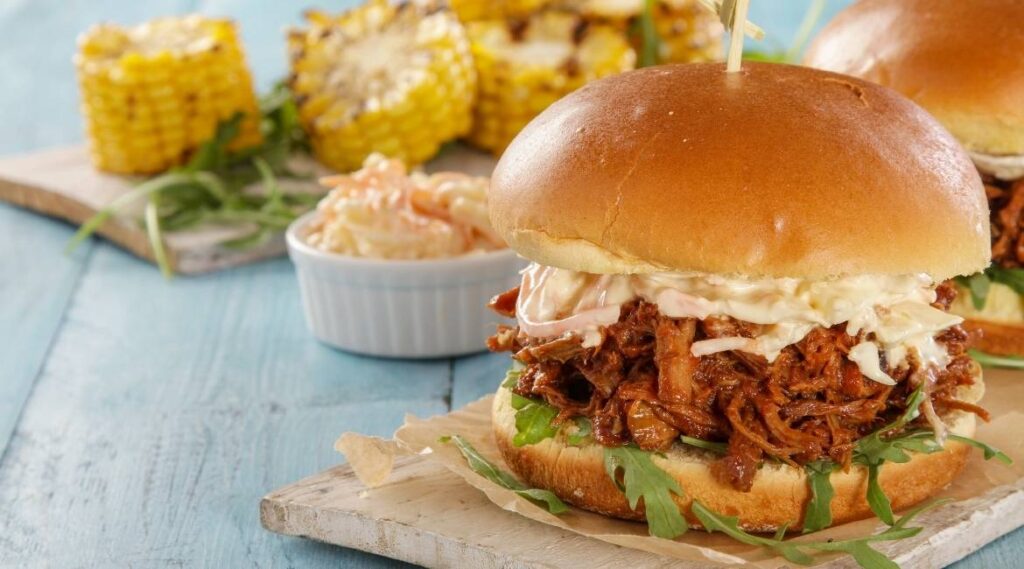
- Slow Cooker Crispy Carnitas from The Modern Proper
- Honey Chipotle Meatball Meal Prep Bowls from Sweet peas and Saffron
- Pot Root Beer Pulled Pork Sandwiches from Six Sisters’ Stuff
- Pork and garlic sausage rolls from Patisserie Makes Perfect
- Southwest pork chops from Taste of Home
- Apple and pork meatballs from Cooked and Loved
- Juicy hamburgers from Weekend at the Cottage
- Hunan pork bites from Meal Plan Addict
- Salt and pepper ribs from Pinch of Nom
Fish Batch Cooking Recipes:

- Smoked haddock with creamy tomato pepper sauce from Living chirpy
- Salmon stuffed peppers from Once a Month Meals
- Fish kofta curry from Sainsbury’s Magazine
- Low carb salmon patties from This Moms Menu
- King prawn masala curry from The Bellephant
- Shrimp egg rolls from Damn Delicious
- Chinese salt and pepper fish from Honest Food
- Bacon shrimp and corn chowder from The Blond Cook
- Breaded fish fillets from Once a Month Meals
- Jouls fish pie from Jamie Oliver
Batch Cooking Desserts:

- Pineapple upside down cake from The Spruce Eats
- Strawberry oatmeal cups from Six Sisters’ Stuff
- Apple pie from Joyfully Thriving
- Meal prep chia pudding from Downshiftology
- Mini mint cheesecakes from Small Town Woman
- Cinnamon rolls from Walking on Sunshine Recipes
- Stuffed French toast from Carlsbad Cravings
- Cookie dough brownie cookies from Taste of Lizzy
- Blueberry cream pie from The Kitchen is my Playground
Tips for Batch Cooking:
Make a plan – Without a plan, it’s all too easy to end up with a fridge full of half-used ingredients and a lot of wasted food.
Containers – Make sure you have enough storage containers. Glass or freezer-safe plastic containers work well for storing batch-cooked food. Another option is freezer bags, especially for single-potion meals.
Pick the right recipes – Choose recipes that can be easily doubled or tripled. Soups, stews, and casseroles are all good choices.
Undercook veggies and pasta – Vegetables lose nutrients as they cook, so undercooking them will ensure they retain more of their vitamins and minerals. Plus, undercooked vegetables will still be tender and tasty, so you won’t have to worry about them being tough or overcooked. Pasta is also better undercooked, so it doesn’t become soggy when reheated.
Cool foods before freezing – If you put hot food straight into the freezer, it can raise the frozen food’s temperature around it, leading to premature thawing and bacteria growth. Instead, give your cooked food plenty of time to cool down to room temperature before transferring it to the freezer.
Label – Label each container with the recipe’s name and the date it was cooked. This will help you track what you have on hand and plan your meals accordingly.
Defrost in the fridge – The best way to defrost food is in the fridge. This slow, steady process preserves the food’s flavour and nutrition. Plus, it helps to prevent the growth of bacteria. So next time you’re tempted to let your food sit on the counter, remember that the fridge is always the best choice.
Final Thoughts
Batch cooking is a great way to stock your kitchen with healthy meals that are easy to reheat and customise. These recipes will help you get started but don’t be afraid to experiment with your own combinations. Once you get the hang of batch cooking, you may never go back to eating unhealthy take-out again. Are you ready to try out some delicious batch-cooked meals?
Remember to check out our related resources for more great recipe ideas.
Thanks so much for stopping by; I appreciate everyone who takes the time to read and make it to the end! I have lots of exciting new content in the next few weeks, so make sure you pop back to catch up!
